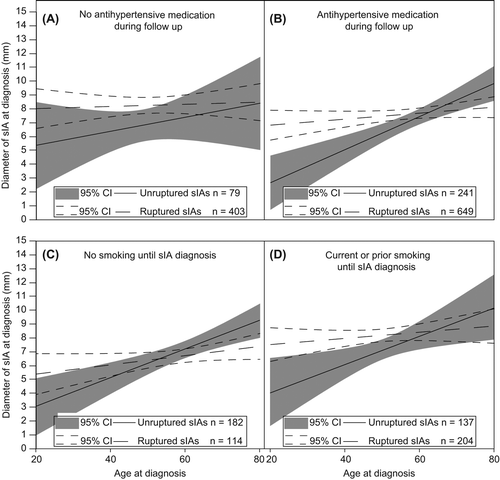Figures & data
Table I. Previous studies on the association of hypertension and angiographically verified saccular intracranial aneurysms since 2000.
Table II. Indications for diagnostic neuroimaging in 467 unruptured sIA patients in 1995–2007 from Eastern Finland.
Table III. Clinical characteristics of 1520 sIA patients in 1995–2007 from Eastern Finland.
Figure 2. Correlation of the age at diagnosis with the diameter of unruptured saccular intracranial aneurysms (sIAs) and ruptured ones (sIA-SAH). Regression lines and 95% confidence intervals (CIs) are shown for unruptured (continuous lines) and ruptured (dotted lines) patients. A and B: The patients without (A) versus with (B) antihypertensive medication during follow-up. The sIA diameter data were available for 320 unruptured sIA patients and 1052 ruptured sIA patients. C and D: The patients without (C) versus with (D) history of smoking (former or current) until the sIA diagnosis. The sIA diameter data and smoking data were available for 319 (182 in C and 137 in D) unruptured sIA patients and 318 (114 in C and 204 in D) ruptured sIA patients. The unruptured sIAs that caused symptoms were removed from the analysis.

Figure 1. Incidence of hypertension in 467 unruptured saccular intracranial aneurysm (sIA) patients and 1053 ruptured ones (sIA-SAH) by the 10-year age groups and their 95% confidence intervals. A: Patients with antihypertensive medication started before the sIA diagnosis. Follow-up time ends at the start of antihypertensive medication or the time of sIA diagnosis. B: Patients with antihypertensive medication started before or after the sIA diagnosis. Follow-up time ends at the start of antihypertensive medication, death, or 31 December 2008.

